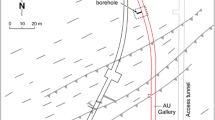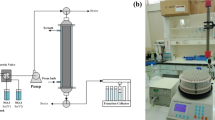Abstract
Transport of nonreactive (tritium, HTO) and anion radionuclides through two columns with different diameters was experimentally and mathematically examined for three inflow rates. One-dimensional advective–dispersive experiments were effectively designed to investigate radionuclide transport through a numerical calibration/validation nonequilibrium model. The two columns were filled with crushed granite, and transport of HTO and two iodine species—iodate (IO3−) and iodide (I−)—through them was studied to obtain breakthrough curves for a water-saturated condition. The significance of I− was found in the smaller column for an input flow rate of 5 mL/min. The accelerated transport of I− may have resulted from anion exclusion, and its relatively stronger Coulomb repulsive force was probably because of its smaller hydration radius than IO3−.







Similar content being viewed by others
Data availability
The datasets generated during and/or analyzed during the current study are available from the corresponding author on reasonable request.
References
IAEA (1985) Deep underground disposal of radioactive wastes: near-field effects. Technical report series no. 251, Vienna
Hansen FD, Hardin EL, Orrell A (2011) Geologic disposal options in the USA. International high-level radioactive waste conference. American Nuclear Society Albuquerque NM, pp 934–940
Taiwan Power Company (2017) The technical feasibility assessment report on spent nuclear fuel final disposal—the spent nuclear fuel final disposal program potential host rock characterization and evaluation stage https://www.aec.gov.tw/share/file/fcma/gdMHvDtHUaPuzszgY5ycfg_pdf
Wang J, Chen L, Su R, Zhao X (2018) The Beishan underground research laboratory for geological disposal of high-level radioactive waste in China: planning, site selection, site characterization and in situ tests. J Rock Mech Geotech Eng 10:411–435
Ewing RC (1999) Less geology in the geological disposal of nuclear waste. Science 286:415–417
Ewing RC, Whittleston RA, Yardley BWD (2016) Geological disposal of nuclear waste: a primer. Elements 12:233–237
Geckeis H, Schäfer T, Hauser W, Rabung T, Missana T, Degueldre C, Möri A, Eikenberg J, Fierz T, Alexander WR (2004) Results of the colloid and radionuclide retention experiment(CRR) at the Grimsel Test Site(GTS), Switzerland–impact of reaction kinetics and speciation on radionuclide migration. Radiochim Acta 92:765–774
Bodin J, Delay F, Marsily G (2003) Solute transport in a single fracture with negligible matrix permeability. Hydrogeol J 11:418–454
Chandel A, Swami D (2021) Review of non-equilibrium flow and transport models in saturated porous media. WEENTECH Proc in Energy 7(1):228
Sahimi M (2011) Flow and transport in porous media and fractured rock: from classical methods to modern approaches. Wiley, New York
Tsang YW, Tsang CF, Hale FV, Dverstorp B (1996) Tracer transport in a stochastic continuum model of fractured media. Water Resour Res 32:3077–3092
Cheng HP, Li MH, Li S (2003) A sensibility analysis of model selection in modelling the reactive transport of cesium in crushed granite. J Contam Hydrol 61:371–385
Cheng HP, Yeh GT (1998) Development and demonstrative application of a 3-D numerical model of subsurface flow, heat transfer, and reactive chemical transport: 3DHYDROGEOCHEM. J Contam Hydrol 34:47–83
Chen T, Li C, Liu XY, Wang LH, Zheng Z, Wang XY, Liu CL (2013) Migration study of iodine in Beishan granite by a column method. J Radioanal Nucl Chem 298(1):219–225
Palagyi Š, Stamberg K, Vodickova H, Hercik M (2014) Transport parameters of I- and IO3-determined in crushed rock column and groundwater system under dynamic flow conditions. J Radioanal Nucl Chem 302:647–653
Yuan G, Chen T, Liu P (2019) Migration characteristics study of iodine in crushed Beishan granite column under dynamic flow condition. J Radioanal Nucl Chem 321(2):693
Zaheer M, Wen Z, Zhan H, Chen X, Jin M (2017) An experimental study on solute transport in one-dimensional clay soil. Geofluids 2017:6390607
Lee CP, Wu MC, Tsai SC, Liu CY, Tsai TL, Pan CH, Yang MS (2015) Numerical analysis of transport and retardation for cesium in crushed granite using multi-stage advection-dispersion column experiments. J Radioanal Nucl Chem 304:377–386
Tsai TL, Lee CP, Lin TY, Wei HJ, Men LC (2010) Evaluation of sorption and diffusion behavior of selenium in crushed granite by through-diffusion column tests. J Radioanal Nucl Chem 285:733–739
van Genuchten MTh, Wierenga PJ (1976) Mass transfer studies in sorbing porous media I: analytical solutions. Soil Sci Soc Am J 40(4):473
Šimunek J, van Genuchten MTh (2008) Modeling nonequilibrium flow and transport processes using HYDRUS. Vadose Zone J 7(2):782
Shoormasti NH, Tabatabaei-Nezhad SA (2021) A novel mechanistic anion exclusion model to investigate partially water-saturated transport in soils and shales: a case study of nitrate solution flow. Eur J Soil Sci 73(1):e13194
Gvirtzman H, Gorelick SM (1991) Dispersion and advection in unsaturated porous media enhanced by anion exclusion. Nature 352:793
Li H, Wang J, Mao L, Zhao S, Jia M, Liu Y, Huang S (2022) Safety assessment of Beishan pre-selection area for geological disposal of high-level radioactive waste in China. J Radioanal Nucl Chem 331:2573–2581
Winberg A, Andersson P., Hermanson J, Byegaard J, Cvetkovic V, Birgersson L (2000) Äspö Hard Rock Laboratory: final report of the first stage of the tracer retention understanding experiments, SKB Technical Report TR 00-07, Stockholm, Sweden
Posiva (2012) Safety case for the disposal of spent nuclear fuel at olkiluoto-description of the disposal system. POSIVA 2012-05, Helsinki
Toride N, Leji FJ, van Genuchten MTh (1995) The CXTFIT code for estimating transport parameters from laboratory or field tracer experiments, version 2.0, Research Report No. 137, U. S. Salinity Lab., USDA, ARS, Riverside, CA
Alexander WR, Smith PA, McKinley IG (2003) Modelling radionuclide transport in the geological environment. In: Scott EM (ed) Modelling radioactivity in the environment. Elsevier, Amsterdam, pp 109–145
Mao M, Li R (2004) Simulating nonequilibrium transport of atrazine through saturated soil. Groundw 42(4):500
Neville CJ (2005) ATRANS: analytical solutions for three-dimensional solute transport from a patch source version 2, SS Papadopulos & Associates, Inc., Waterloo, Ontario
Leij FJ, Toride N (1997) N3DADE: a computer program for evaluating nonequilibrium three-dimensional equilibrium solute transport in porous media, Research Report No. 134, U. S. Salinity Lab., USDA, ARS, Riverside, CA
Parker JC, van Genuchten MTh (1984) Determining transport parameters from laboratory and field tracer experiments. Virginia Agricultural Experiment Station, Virginia Polytechnic Institute and State University, US Salinity Lab., USDA, ARS, Riverside. CA
van Genuchten MTh (1981) Non-equilibrium transport parameters from miscible displacement experiments. Research report no. 119, US Salinity Lab., USDA, ARS, Riverside, CA
Bresler E (1973) Anion exclusion and coupling effects in nonsteady transport through unsaturated soils: I. Theory. Soil Sci Soc Am J 37(5):663
Shukla MK, Cepuder P (2000) Anion exclusion during transport of chloride through soil columns. Trans ASAE 43:1425–1430
Shukla MK, Ellsworth TR, Hudson RJ, Nielsen DR (2003) Effect of water flow on solute velocity and dispersion. Soil Sci Soc Am J 67:449–457
Krupp HK, Biggar JW, Nielsen DR (1972) Relative flow rates of salt and water in soil. Soil Sci Soc Am J 36(3):412
Brusseau ML, Jessup RE, Rao PSC (1989) Modeling the transport of solutes influenced by multi-process nonequlibrium. Water Resour Res 25(9):1971
EU FP7/2007–2013 DEMEAU Project (2013) Report Guidelining protocol for soil-column experiments assessing fate and transport of trace organics
Lee CP, Hu Y, Chen D, Wu E, Wang Z, Wen Z, Tien NC, Fan Y, Tsai SC, Shi Y, Liu YL (2021) An improved speciation method combining IC with ICPOES and its application to iodide and iodate diffusion behavior in compacted bentonite clay. Materials 14(22):7056
Marquardt DW (1963) An algorithm for least-squares estimation of non-linear parameters. J Soc Ind Appl Math 26:578–591
Lee CP, Lan LP, Jan YL, Wei YY, Teng SP, Hsu CN (2006) Sorption of cesium on granite under aerobic and anaerobic conditions. Radio Acta 94:679–682
Lee CP, Tsai SC, Wu MC, Tsai TL, Tu YL, Kang LJ (2017) A comparative study on sorption and diffusion of Cs in crushed argillite and granite investigated in batch and through-diffusion experiment. J Radioanal Nucl Chem 311:1155–1162
Tsai SC, Lee CP, Tsai TL, Yu YC (2017) Characterization of cesium diffusion behavior into granite matrix using Rutherford backscattering spectrometry. Nucl Instrum Methods Phys Res B 409:305–308
Lee CP, Chen D, Hu Y, Jan YL, Shi Y, Wang Z, Wu E, Tien NC, Sun Y, Tsai SC (2021) An application of safety assessment for radioactive waste repository: non-equilibrium transport of Tritium, Selenium and Cesium in crushed granite with different path lengths. Appl Sci 11(20):9750
Gaber HM, Inskeep WP, Comfort SD, Wraith JM (1995) Nonequilibrium transport of atrazine through large intact soil cores. Soil Sci Soc Am J 59(1):60
Gamerdinger AP, Wagenet RJ, van Genuchten MTh (1990) Application of two region/two sites models for studying simultaneous nonoequilibrium transport and degradation of pesticides. Soil Sci Soc Am J 54:957–963
NEA (2012) NEA Sorption Project. Phase III: thermodynamic sorption modelling in support of radioactive waste disposal safety cases. OECD-NEA, Paris
SKB, 2004. RETROCK Project. Treatment of geosphere retention phenomena in safety assessments. Scientific basis of retention processes and their implementation in safety assessment model (WP2). SKB technical report R-04-48. SKB, Stockholm, Sweden
van Genuchten MTh, Wagenet RJ (1989) Two site/two region models for pesticides transport and degradation: theoretical development and analytical solutions. Soil Sci Soc Am J 53:1303–1310
Shi Y, Yang S, Chen W, Xiong W, Zhang A, Yu Z, Lian B, Lee CP (2022) Study on tritium and iodine species transport through porous granite: a non-sorption effect by anion exclusion. Toxics 10(9):540
Acknowledgements
This project was mainly supported by the Ministry of Science and Technology (MOST, Taiwan, ROC) and the Atomic Energy Council (AEC, Taiwan, ROC) through a 2-year mutual fund program project under contract numbers 109-2622-E-007-022, 109-2623-E-007-006-NU, and 110-2623-E-007-004-NU. Partial financial support was provided by Start-up funds for doctoral research of the East China University of Technology (No. 1410000434), the CIRP Open Fund of Radiation Protection Laboratories, and the China Institute for Radiation Protection (CIRP), Taiyuan, China.
Author information
Authors and Affiliations
Corresponding author
Ethics declarations
Conflict of interest
The authors declare that there is no conflict of interest regarding the publication of this article.
Additional information
Publisher's Note
Springer Nature remains neutral with regard to jurisdictional claims in published maps and institutional affiliations.
Rights and permissions
Springer Nature or its licensor (e.g. a society or other partner) holds exclusive rights to this article under a publishing agreement with the author(s) or other rightsholder(s); author self-archiving of the accepted manuscript version of this article is solely governed by the terms of such publishing agreement and applicable law.
About this article
Cite this article
Tien, NC., Lee, CP. Effect of anion repulsion on iodine transport through water-saturated crushed granite. J Radioanal Nucl Chem 332, 935–946 (2023). https://doi.org/10.1007/s10967-022-08653-y
Received:
Accepted:
Published:
Issue Date:
DOI: https://doi.org/10.1007/s10967-022-08653-y




